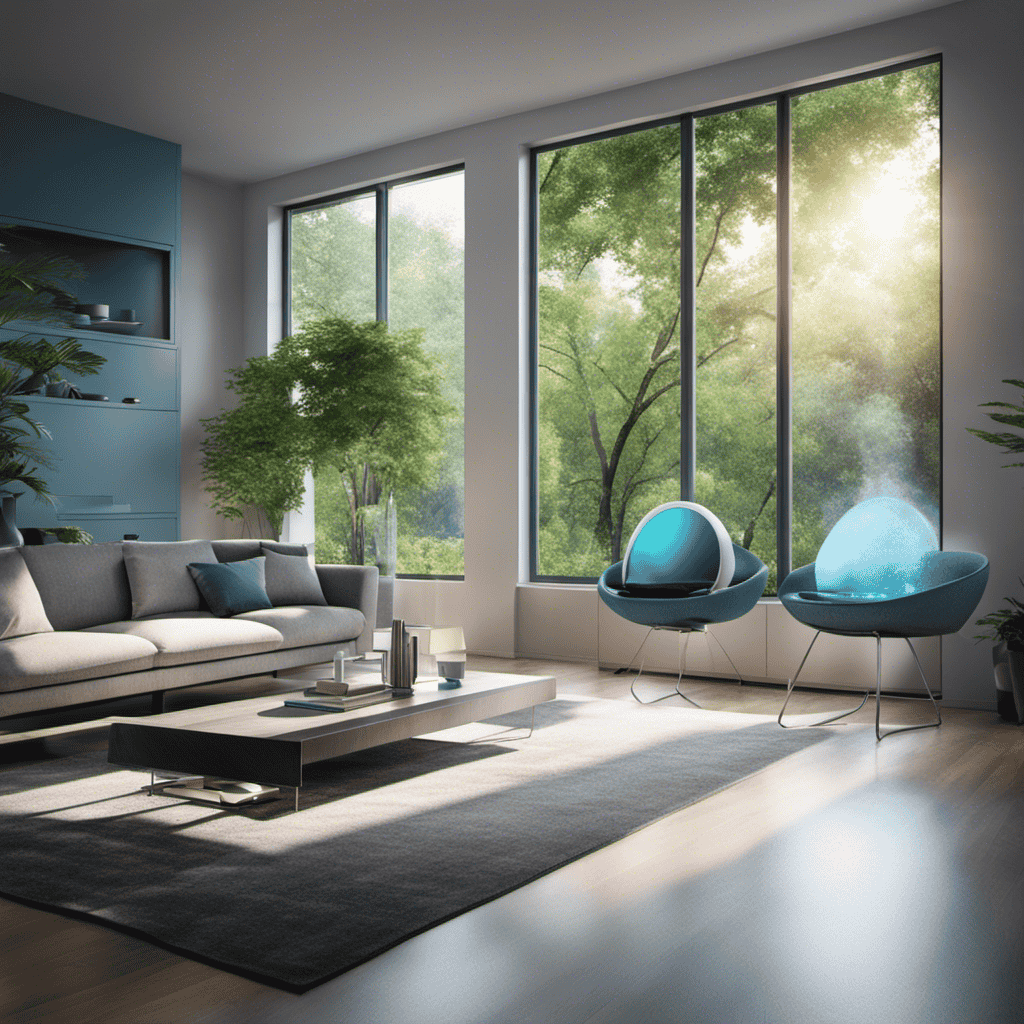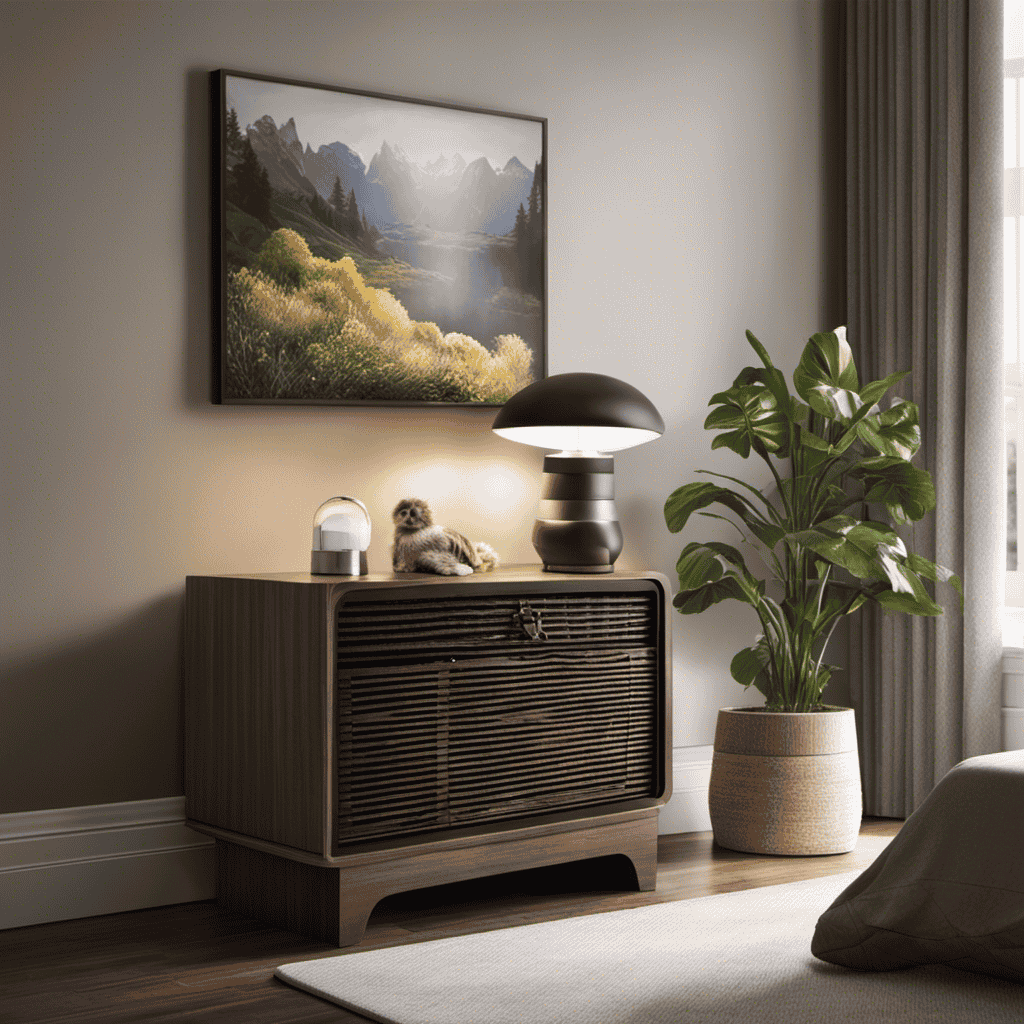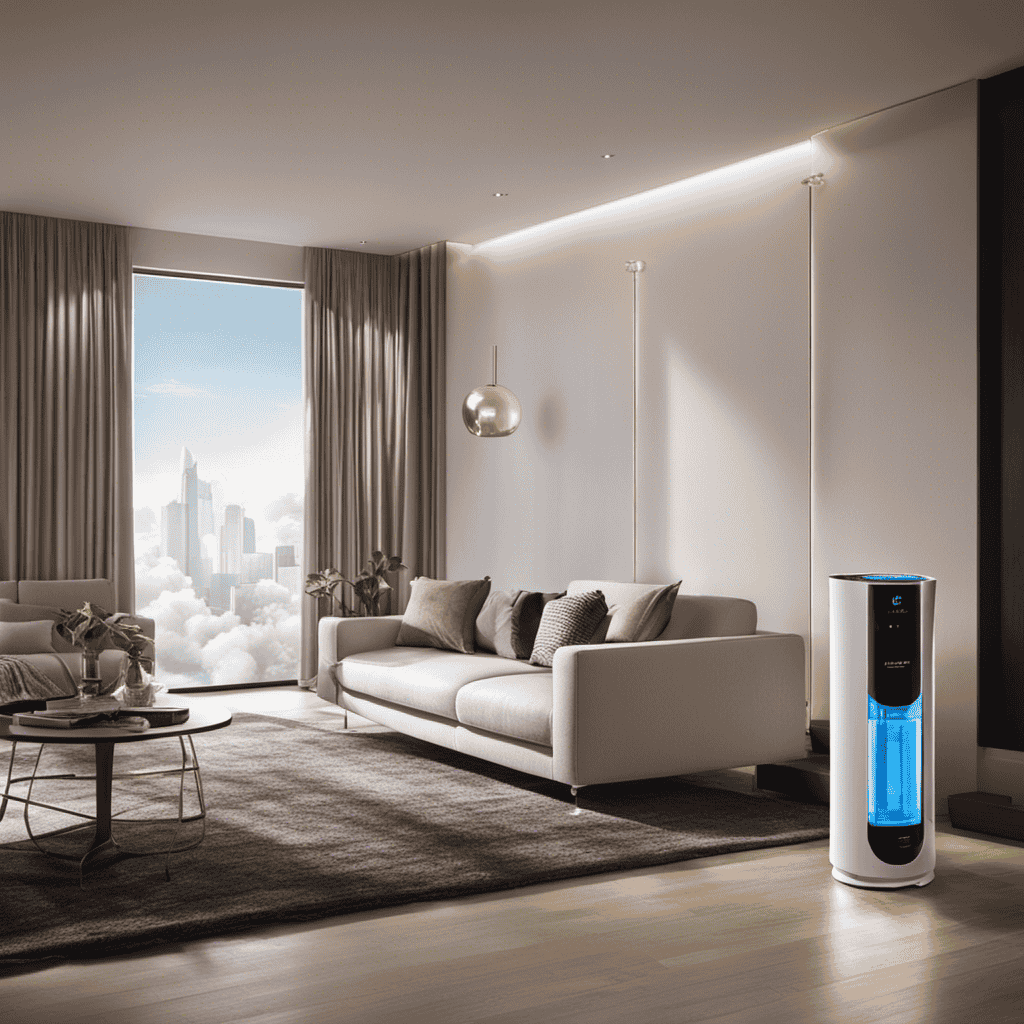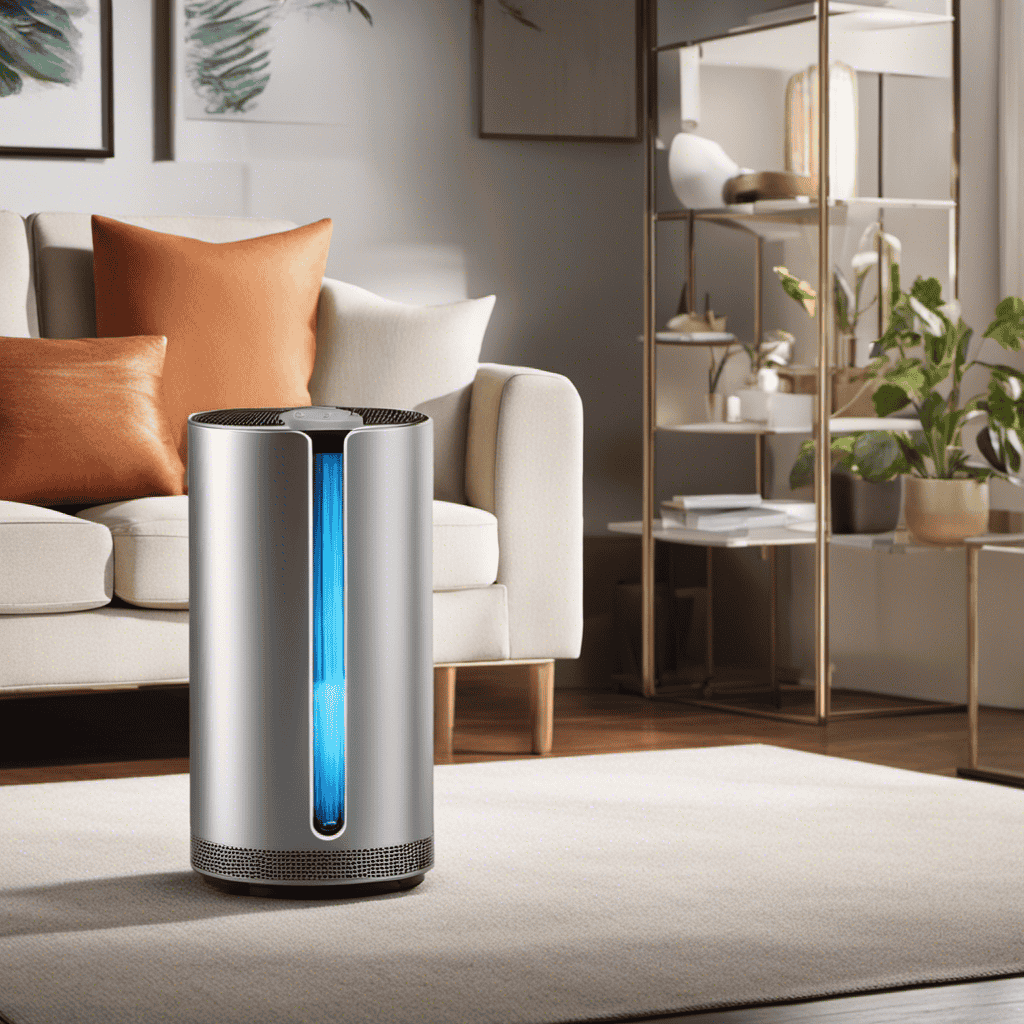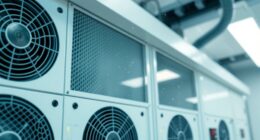As someone who suffers from allergies, I understand the significance of finding the top air purifier to help ease symptoms.
Did you know that the average person spends about 90% of their time indoors, where the air can be two to five times more polluted than outdoor air?
That’s why choosing the right air purifier is crucial.
In this article, I will explore the different types of air purifiers, key features to consider, and provide evidence-based recommendations to help you make an informed decision for your allergy relief.
Key Takeaways
- HEPA filters are the most effective for removing allergens.
- Consider the size of the area you need to purify when choosing an air purifier.
- Activated carbon filters are effective in eliminating odors and gases.
- Evaluate potential health risks associated with ozone exposure before using an ionizer or ozone generator.
Different Types of Air Purifiers
If you have allergies, you’ll want to know about the different types of air purifiers available.
There are several air purifier brands on the market, each offering different features and technologies to help alleviate allergy symptoms. Some popular brands include Dyson, Honeywell, and Blueair.
When comparing the cost of air purifiers, it’s important to consider not only the upfront price but also the long-term expenses. Some air purifiers may have a higher initial cost but lower maintenance and filter replacement costs, while others may be cheaper upfront but require more frequent filter changes.
Additionally, it’s important to consider the size of the area you need to purify, as larger rooms may require more powerful air purifiers.
Key Features to Consider
When choosing an air purifier, two key features to consider are filter type effectiveness and room size coverage.
The effectiveness of the filter type determines how well it can remove pollutants from the air, such as allergens, dust, and pet dander.
The room size coverage indicates the maximum area that the air purifier can effectively clean, ensuring that the air in your entire room is purified.
Filter Type Effectiveness
The HEPA filter is highly effective at removing allergens from the air. It is recommended to choose an air purifier with a HEPA filter for optimal allergy relief.
When considering room size recommendations, it is important to select an air purifier that is suitable for the size of the room you intend to use it in. Air purifiers usually come with room size recommendations, so be sure to check the manufacturer’s guidelines.
Additionally, energy efficiency is another important factor to consider. Look for an air purifier with an Energy Star rating, as these models are designed to use less energy while still providing excellent filtration.
Room Size Coverage
To ensure optimal performance, choose an air purifier that is suitable for the size of your room and provides adequate coverage.
The optimal room size for an air purifier depends on its Clean Air Delivery Rate (CADR). The CADR measures the amount of clean air that the purifier can deliver per minute.
Typically, air purifiers are designed for specific room sizes, such as small, medium, or large rooms. It is important to choose an air purifier that matches the size of your room to ensure efficient and effective air purification.
Additionally, consider the noise levels of the air purifier. Some models can be quite loud, which may be disruptive, especially if you plan to use it in your bedroom or office.
Look for air purifiers that have low noise levels, typically measured in decibels (dB), for a quieter and more peaceful environment.
HEPA Filtration: The Gold Standard
You’ll want an air purifier with HEPA filtration if you’re looking for the gold standard in allergy relief. HEPA, which stands for High Efficiency Particulate Air, filters out 99.97% of particles as small as 0.3 microns.
But what if you’re looking for alternatives to HEPA filtration that are more cost-effective? Here are four options to consider:
-
Activated Carbon Filters: These filters are effective at removing odors, gases, and chemicals from the air. While they may not capture as many allergens as HEPA filters, they can still help improve indoor air quality.
-
Ionizers: Ionizers release negatively charged ions into the air, which attach to allergens and make them heavier, causing them to fall to the ground. However, they don’t actually remove the particles from the air, so regular cleaning is necessary.
-
UV-C Light: Ultraviolet light can destroy the DNA of mold, bacteria, and viruses, effectively killing them. However, UV-C light is not as effective at capturing larger particles like pollen and dust.
-
Electrostatic Filters: These filters use an electrostatic charge to attract and capture particles. While they can be effective, they may require frequent cleaning to maintain optimal performance.
While these alternatives may not offer the same level of filtration as HEPA, they can be more budget-friendly options for allergy relief.
Ionizers and Ozone Generators: Pros and Cons
While HEPA filtration is widely regarded as the gold standard for air purifiers, there are other options available. Ionizers work by emitting negatively charged ions into the air, which attach to and remove airborne particles.
On the other hand, ozone generators produce ozone, a molecule that can help eliminate odors and kill certain bacteria and viruses. However, it’s important to note that ozone exposure can have health effects. High levels of ozone can irritate the respiratory system, leading to coughing, throat irritation, and shortness of breath. Prolonged exposure to ozone may also worsen existing respiratory conditions, such as asthma.
Therefore, when considering an air purifier with ionizer or ozone generator, it is crucial to carefully evaluate the potential health risks associated with ozone exposure.
Activated Carbon Filters: Eliminating Odors and Gases
When it comes to eliminating odors and gases, activated carbon filters are highly effective. These filters are designed to trap and remove harmful chemicals and indoor air pollutants, providing cleaner and fresher air for your home or office. Here are four reasons why activated carbon filters are a popular choice for air purification:
-
Adsorption: Activated carbon has a porous structure that allows it to adsorb odors, gases, and volatile organic compounds (VOCs) by trapping them within its tiny pores.
-
Chemical Filtration: The activated carbon in these filters chemically reacts with the pollutants, neutralizing them and eliminating their harmful effects.
-
Versatility: Activated carbon filters can effectively remove a wide range of odors and gases, including smoke, pet odors, cooking smells, and chemical fumes.
-
Longevity: These filters have a longer lifespan compared to other types of filters, making them a cost-effective option for maintaining clean and fresh indoor air.
With their ability to eliminate chemicals and indoor air pollutants, activated carbon filters are an excellent choice for improving air quality. However, they are not the only technology available to combat airborne contaminants.
Transitioning to the subsequent section, let’s explore UV-C light technology and its effectiveness in killing germs and viruses.
UV-C Light Technology: Killing Germs and Viruses
When it comes to effectively eliminating germs and ensuring a clean and healthy environment, UV-C light technology is a game-changer. This innovative technology has been scientifically proven to kill germs and viruses, providing an extra layer of protection against harmful pathogens.
Not only does UV-C light technology offer effective germ elimination, but it also provides additional benefits such as allergy relief, making it a valuable addition to any air purification system.
Effective Germ Elimination
To effectively eliminate germs, you’ll want an air purifier that uses a HEPA filter. Here are four reasons why this type of air purifier is the best choice for germ elimination:
-
HEPA filter: High-Efficiency Particulate Air (HEPA) filters are designed to capture 99.97% of airborne particles as small as 0.3 microns. This includes bacteria, viruses, and other germs that can cause illness.
-
Traps germs: HEPA filters have a dense fiber network that effectively traps and holds germs, preventing them from circulating in the air and reducing the risk of inhaling them.
-
Improves air quality: By removing germs, a HEPA air purifier helps maintain clean and healthy air in your home or office. This can lead to a range of benefits, including reduced allergies, improved respiratory health, and better overall well-being.
-
Long-lasting protection: HEPA filters are durable and can last for several months, depending on usage. Regularly replacing the filter ensures continued germ elimination and optimal performance of the air purifier.
Allergy Relief Benefits
By removing allergens, a HEPA filter helps provide relief from allergy symptoms. When it comes to finding allergy relief methods, many people turn to natural remedies. These remedies can be effective in reducing the severity of allergy symptoms and improving overall well-being. Here is a comparison of some popular natural remedies for allergies:
| Natural Remedy | Benefits |
|---|---|
| Quercetin | Acts as an antihistamine and reduces allergic reactions |
| Butterbur | Relieves nasal allergy symptoms and has anti-inflammatory effects |
| Probiotics | Helps regulate the immune system and reduce allergic responses |
Incorporating these natural remedies into your daily routine may provide some relief from allergy symptoms. However, it’s important to note that everyone’s allergies are different, and what works for one person may not work for another. It is always a good idea to consult with a healthcare professional before starting any new allergy relief methods. Transitioning into the next section, let’s explore air purifiers specifically designed for targeting common allergens such as dust, pollen, and pet dander.
Air Purifiers for Specific Allergens (Dust, Pollen, Pet Dander
If you’re looking to tackle specific allergens like dust, pollen, or pet dander, the best air purifiers for you are the ones equipped with HEPA filters. These filters are designed to capture particles as small as 0.3 microns, which includes common allergens like dust mites and mold spores.
Here are four reasons why HEPA filters are effective for dust mite prevention and mold spore filtration:
-
High Efficiency: HEPA filters have a high efficiency rate of 99.97% in capturing allergens, ensuring cleaner air for allergy sufferers.
-
Dust Mite Prevention: HEPA filters can capture the microscopic particles that dust mites produce, reducing their presence in your home.
-
Mold Spore Filtration: HEPA filters are capable of trapping mold spores, preventing them from spreading and potentially causing respiratory issues.
-
Allergen Removal: HEPA filters remove a wide range of allergens, including pollen and pet dander, providing relief from allergy symptoms.
Investing in an air purifier with a HEPA filter is a smart choice for individuals looking to minimize the impact of specific allergens in their environment.
Room Size and Air Purifier Capacity
When it comes to choosing the right air purifier, it’s important to consider the optimal room size and matching capacity requirements.
The size of the room plays a crucial role in determining the efficiency of the air purifier.
A room that is too large for the purifier’s capacity may not effectively clean the air, while a purifier that is too powerful for a small room may be overkill.
Optimal Room Size
To determine the optimal room size for an air purifier for allergies, you should consider the square footage of the area you want to purify. Here are four factors to take into account when determining the optimal room size for an air purifier:
-
Optimal Placement: It is important to place the air purifier in a central location within the room to ensure proper air circulation and filtration. This will help the purifier effectively remove allergens from the entire space.
-
Energy Consumption: The size of the room will impact the energy consumption of the air purifier. A larger room may require a purifier with a higher CADR (Clean Air Delivery Rate) to effectively clean the air, which may result in higher energy consumption.
-
Allergen Levels: Consider the severity of your allergies and the allergen levels in your specific area. If you live in a highly polluted or allergen-rich environment, a larger air purifier may be necessary to effectively remove allergens from the air.
-
Room Configuration: If the room has multiple openings or is connected to other areas, you may need to consider a larger air purifier to ensure proper coverage and filtration of air from all sources.
Considering these factors will help you determine the optimal room size for an air purifier for allergies, ensuring that the purifier effectively cleans the air and provides relief from allergens.
Now let’s move on to the next section about matching capacity requirements.
Matching Capacity Requirements
To find the right air purifier for your needs, you should consider matching the capacity requirements to the size of the room you want to purify. This ensures that the air purifier can effectively clean the air in your space. The capacity of an air purifier is measured in terms of the maximum area it can cover or the volume of air it can clean per hour. It’s important to choose an air purifier with a capacity that matches or slightly exceeds the size of your room.
Another factor to consider is energy efficiency. Look for air purifiers that are Energy Star certified, as they are designed to consume less energy while still providing effective air purification. This not only helps to reduce your energy bills but also has a positive impact on the environment.
Incorporating these factors into your decision-making process will help you choose an air purifier that is both effective in purifying the air and energy efficient.
| Capacity | Room Size | Air Changes per Hour |
|---|---|---|
| Small | Up to 150 sq. ft. | 4-6 |
| Medium | 150-300 sq. ft. | 3-5 |
| Large | 300-600 sq. ft. | 2-4 |
Noise Levels: Finding a Quiet Solution
Finding a quiet solution for allergies involves considering the noise levels of different air purifiers. When searching for quiet air purifiers, it’s important to look for models that utilize noise reduction technology.
Here are four factors to consider when looking for a quiet solution:
-
Decibel Levels: Look for air purifiers that have low decibel ratings, typically below 50 dB, to ensure minimal noise disruption.
-
Fan Speed Settings: Opt for air purifiers with multiple fan speed settings, allowing you to adjust the noise level to your preference.
-
Design and Construction: Choose air purifiers with built-in soundproofing features or insulated cabinets to reduce noise transmission.
-
Sleep Mode: Some air purifiers have a sleep mode that operates at a low noise level, making them ideal for use in bedrooms.
In conclusion, finding a quiet air purifier involves considering decibel levels, fan speed settings, design and construction, and the availability of sleep mode. This ensures a peaceful environment while effectively reducing allergens.
Now, let’s explore the next section about maintenance and filter replacement.
Maintenance and Filter Replacement
When it comes to maintenance and filter replacement, remember to regularly clean and replace the filters in your air purifier. Proper maintenance is essential for ensuring that your air purifier functions effectively and efficiently.
Cleaning the filters at least once a month can help remove dust, pollen, and other particles that accumulate over time. This not only improves the air quality in your home but also prolongs the life of your filters.
When it’s time to replace the filters, make sure to follow the manufacturer’s guidelines and choose high-quality replacements. Investing in good filters will ensure that your air purifier continues to remove allergens and contaminants from the air, providing a clean and healthy environment for you and your family.
Frequently Asked Questions
Are Air Purifiers Effective in Eliminating Allergens Like Dust, Pollen, and Pet Dander?
Yes, air purifiers are effective in reducing indoor air pollution by eliminating allergens like dust, pollen, and pet dander. Using an air purifier provides benefits for people with allergies by improving air quality and reducing allergy symptoms.
How Do I Determine the Right Size Air Purifier for My Room?
To determine the right size air purifier for my room, I consider the square footage and the Clean Air Delivery Rate (CADR) of the purifier. This ensures effective allergen removal and helps maintain good air quality while minimizing noise levels.
Can Air Purifiers Completely Eliminate Odors and Gases From the Air?
Yes, air purifiers can eliminate odors and gases from the air. They use advanced technology to capture and neutralize these pollutants, improving indoor air quality and providing numerous benefits for allergy sufferers like me.
Do Air Purifiers Require Regular Maintenance, and How Often Should the Filters Be Replaced?
Air purifiers do require regular maintenance. The filters should be replaced every 6 to 12 months, depending on the model. It’s important to follow the manufacturer’s guidelines for optimal performance and to ensure clean air.
Are There Any Potential Health Risks Associated With Using Ionizers or Ozone Generators in Air Purifiers?
There may be potential health risks associated with using ionizers and ozone generators in air purifiers. It is important to consider the effectiveness of these features while also prioritizing the safety of your respiratory health.
Conclusion
In conclusion, choosing the right air purifier for allergies is like finding a key to unlock a world of relief.
Just as a gentle breeze soothes the weary soul, a high-quality air purifier can alleviate the burden of allergens in the air.
With features like HEPA filtration and activated carbon filters, these devices act as guardians, shielding us from the invisible enemies that trigger our allergies.
Remember, the size of the room and noise levels matter too, so choose wisely.
Breathe easy and embrace the purity that awaits you.
